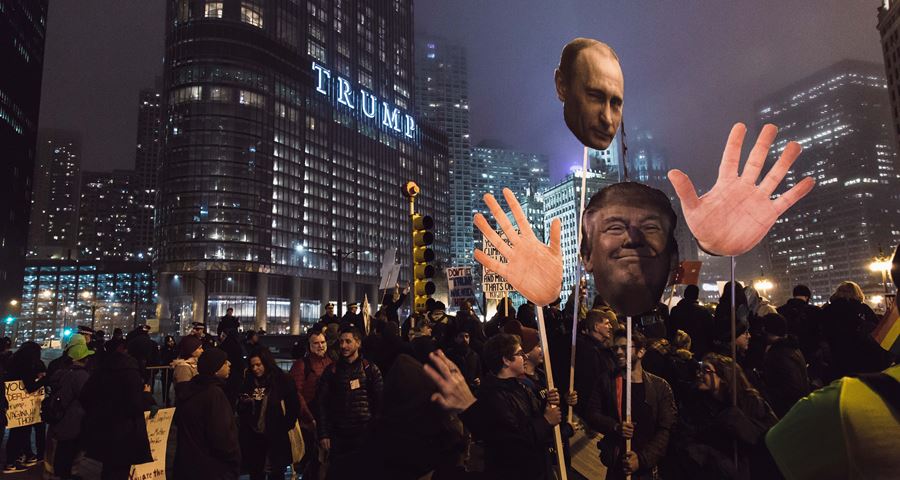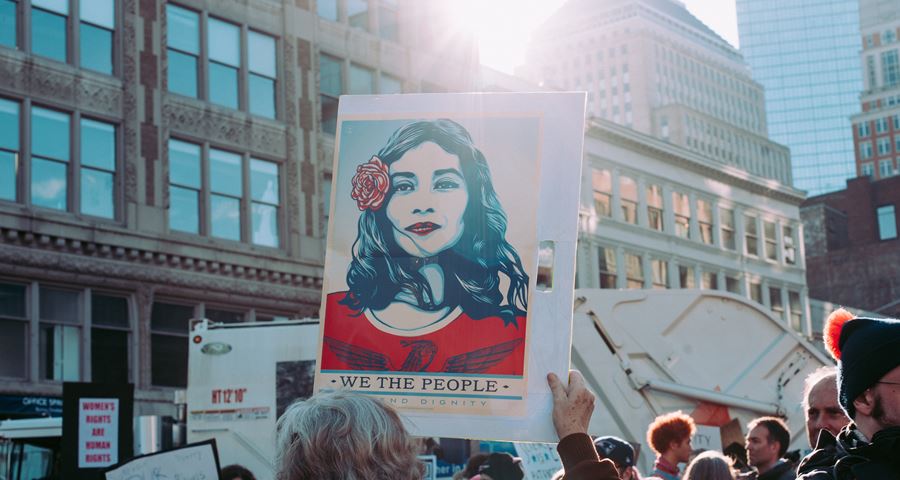Spoken Word Artist Hope to Nope: Graphics and Politics 2008 - 2018
Q&A with Deanna Rodger
In this Q&A, Deanna explains her source of inspiration for the poem and which event from the last ten years has had the biggest impact on her. Find out out why she thinks music is a tuneful force for political change, what's her concern over the rise of click bait and whether she thinks the current generation are becoming more politicised.
Q: How did you get into spoken word?
I went to a workshop at the Lyric Hammersmith, which is 10 minutes down the road from the Design Museum. When I was seventeen, my friend wanted to go and didn’t want to go alone so I signed up too. I went along and was like, “woah, didn’t know this was poetry”. It’s definitely not what we were taught in school and I was hooked.
Q: Can you talk us through your writing process for your spoken word poetry?
My process changes depending on what I’m writing and for whom and for when. I love the research part of it and I love figuring out all the different words you can use that can have a sub-text or double-meaning. So I often find myself going down rabbit holes looking up really weird stuff. I have to put that to the side and just write. It’s usually free writing, so just writing and writing for however many minutes I can stand it and pushing myself to do that because it’s quite hard when you feel like you need to get something right. I then sculpt something from that.
I would always write in a kind of natural rhythm and grab images off the cuff. You then just refine your writing, make sure it makes sense, all the pronouns are there and the tenses are consistent. I think it’s important to be really honest. Not, “what’s the prettiest way I can say this?” but “what am I actually saying?” For me that’s interesting because it’s not cliché.
Q: Are there any certain literary figures that you have special admiration for?
I’m really lucky to have worked with people who have inspired me. Dean Atta is one of them. He was my facilitator at the workshop I started at. We now work together and run an event called “come rhyme with me”.
I am also inspired by Adam Kammerling. He is a rapper and now combines his words with dance and everything he writes is beautiful. Also Raymond Antrobus, who I competed with in a slam ten years ago and we have been friends and colleagues ever since. He is deaf so a lot of his work is dedicated to getting BSL recognised as poetry. I think he is going from strength to strength.
Simon Mole is another inspiration, as he is a kid’s genius. He is a rapper and can write a rap for any kid and still sound super-cool. There’s also Mr Gee who is really wise and has a good head for understanding this spoken word scene and the industry. I would also say, Hollie McNish who I have known for years. I love how much of herself she brings to the stage and how authentic she is in her writing and delivery.
Then you’ve got Margaret Atwood who inspired me as a writer, not just a reader. She’s so witty and intelligent and I just love how her words are so clean but busy underneath. But I also love Mariah Carey, she’s one of my heroes and her ability to connect so emotionally with her words has inspired me to be so emotionally open on stage and allow my voice to go to those spaces. And Bjork, who is so magical!

Q: Which event do you remember the most from the last ten years? Do you remember where you were at the time?
I remember the 7/7 bombings really well because I was at my best friend’s house for a sleepover. I remember my mum saying “don’t get on public transport” and me saying, “Mum I need to get home somehow; I’m not going to walk!” We took it really seriously, but I knew life had to go on and that we couldn’t live in fear. Fear is natural, but you need to always push on to see something more beautiful in front of you.
I also remember the Olympics. I remember feeling very politically charged about how people had to move out of their houses and the clearance of the space and not feeling that comfortable with it. I remember and recall feelings better than actual events.
Q: Is there a graphic design which particularly stood out for you?
The one I reference in this piece, “if you’re not outraged, then you’re not paying attention”. I’ve got the sign at home because I was really taken back by it. I found the Occupy Movement really powerful, seeing people moving their lives on to the street all across the globe. That as an image allowed us to think “what do we need in order to survive?” “What does it mean to occupy public space and what does it mean for space to be privatised and how does that impact us as humans?”

Q: What was the initial motivation for your piece?
I was given the brief by the Design Museum to write this poem for the Hope to Nope exhibition, which explores political graphics from 2008 to 2018. I like working to commission, where you have to hit certain targets. I find that very liberating and I treat it like a challenge. I started to think what do I remember about 2018? How is this connected to now? I wanted this piece to be messy and pirouette, slipping as quickly as the news is printed, as quickly as our twitter timeline moves.
I feel that we have moved into a time of globalisation. That more and more we are seeing the impacts of past decisions, in far away countries, on our own. I wanted this poem to demonstrate the blurring of such lines, whilst being acutely aware of the divisions that have flared up. The causal use of word association allowed me to slide from topic to topic, which I feel also highlights the differences and similarities between people in vastly different circumstances, for instance, 'hipster beards have been commuting continents on settler faces / Instagram influencers rocking that refugee vogue.’
Q: What message do you want to convey to your listeners when they hear this poem? What do you want them to take out of it?
That many things are happening at the same time and to pay attention! There are certain times where the display of outward rage is appropriate. The outrage doesn’t have to be violent; it can be saying something out loud, holding a placard, refusing to buy something from somewhere or having a difficult conversation with your peers.
Q: Do you think people of this generation are more politicised compared to the previous generation?
I think it has changed form. We have social media to demonstrate that. I think people were having conversations around dinner tables and in other spaces, but it is more public and accessible. There are amazing movements such as Sisters Uncut, who are so upfront and unabashed in protecting women’s rights in really public ways. There are pros and cons with social media as a platform for projecting your voice.
Q: You mention “fake news”, “click bait” and the rise of instant fame in your poem. In what way do you think the internet and technology has changed the way that we consume information?
There’s some much to click and it’s easy on your phone. “Click, swipe, swipe”. It’s all surface and no depth. Even my friend the other day had such a negative opinion about this film, “Shape of Water”, saying it was about bestiality. Then a week later, he said the film was really cool. He just heard the bestiality rumour in the pub and regurgitated what he heard! And I think that’s what a lot of people do with news. I don’t think that there is enough critical analysis on news articles; there are no questions about who is funding it or what the agenda is. Even when a piece seems neutral, there is always an agenda.

Q: Why do you think music has become a tuneful force for political change? Which artists have had a particular impact on you?
Music has a rhythm that our whole system moves to subconsciously, like a heartbeat or a tempo. It does something to us physiologically and emotionally. Whether you are listening to classical music or grime, music does something to your heartbeat and you start to mirror it. That’s why music has always been there and present.
Kendrick Lamar has made an impact on me. I think his DAMN album is brilliant as it gives me an insight into black lives in America in 2018. War takes on different forms. In essence, the civil rights movement has evolved into Black Lives Matter and phones and technology are used to illuminate the ‘war’ between systemically racist institutions and people of colour.
Q: The animal references in your piece are meant to symbolise political leaders. Can you tell us a little bit more about this?
I feel this is at once generous and insulting: Theresa May and her billion pound paw and leopard print shoes, replacing David Cameron with “pig-gate” clinging to Donald Trump and the Americana symbol of the eagle. There is a ignorant superiority we feel as humans over animals. With all our pre-frontal, new-brain consciousness, sometimes I feel that decisions and laws are made for the basic short-term survival of a political party, not for the survival of the human species. For example, the intense interrogation of asylum seekers rather than trial and repercussions for self-interested corporations who are not only reaping reward from general public’s austerity but are also causing a huge amount of damage to our earth’s environment.
Q: It was International Women’s Day last week (8 March); do you have a message for young women considering a career in spoken word?
Do it! Trust yourself and trust that your experiences are important. No-one else has your eyes, ears or how your brain puts words together and interprets this world.

watch now
Find out more